#Nicholas Albert Photography
Text
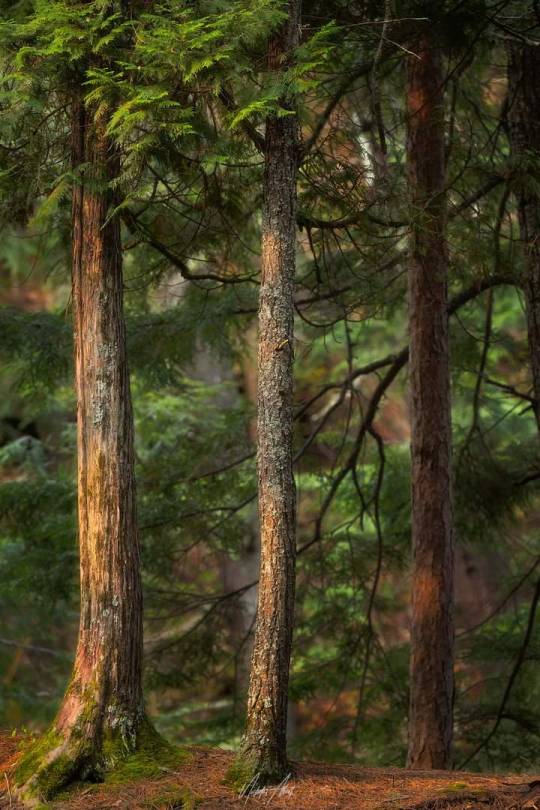
Dappled light paints trees along the Presque Isle River in Michigan's Porcupine Mountains.
📸 by Nicholas Albert Photography
#Nicholas Albert Photography#Upper Peninsula#Porcupine Mountains#Pure Michigan#Trees#Nature#Travel#Photography
18 notes
·
View notes
Text

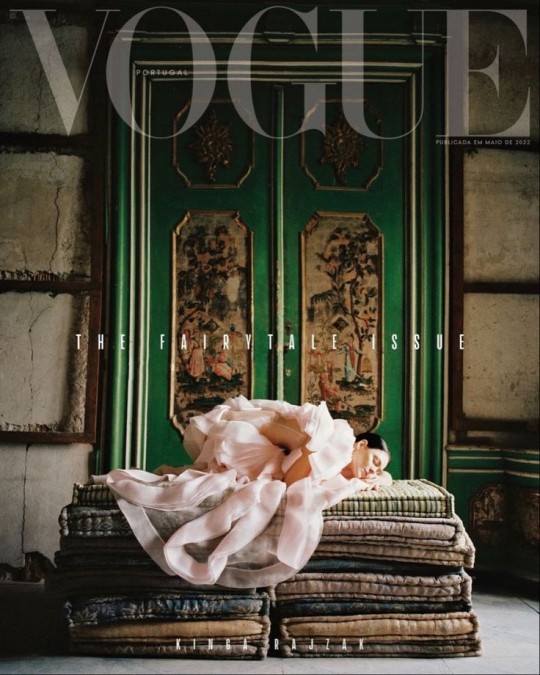


Vogue Portugal May, June 2022
Cover 1
model Clara Mc Sweeney editor-in-chief Sofia Lucas cover art direction José Santana photography Albert Watson styling Daniel Edley hair @tomikono_wig makeup @ayaminishimura @yumi_mori
Cover 2
model Kinga Rajzak Editor in chief Sofia Lucas Cover art direction Jose Santana photography Branislav Simoncik styling @ninaford hair Renáta Marová makeup Lubica Krajnakova
Cover 3
model Nikki Kahr creative direction and photography Alexandra Shopie editor-in-chief Sofia Lucas cover art direction José Santana styling Audrey Tailleé hair and makeup @aurelia.liansberg
Cover 4
model Milly Holmes creative direction and photography Elio Nogueira editor-in-chief Sofia Lucas cover art direction José Santana styling @newheartnyc hair and makeup Marianne Tamposi production Nicholas Tamposi
More Vogue Covers On Pinterest
#clara mc sweeney#albert watson#vogue portugal#kinga rajzak#branislav simoncik#may/june#vogue cover#nikki kahr#alexandra shopie#cover magazine#milly holmes#elio nogueira#vogue magazine
4 notes
·
View notes
Text
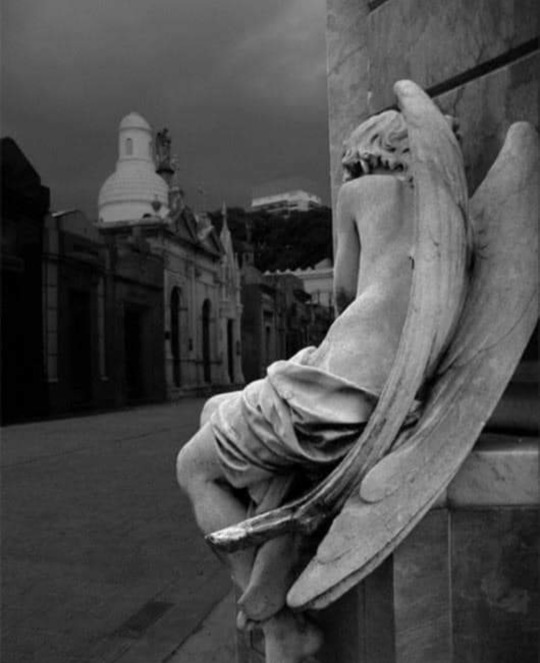
"Where there is no hope, it is incumbent on us to invent it." (Albert Camus) by Nicholas Bell photography
Via Virginija Drungil
0 notes
Photo




Happy National Best Friends Day! Today honors those special people we can always count on. Whether you’ve known them your entire life or only recently, a best friend makes tough times bearable and fun times memorable.
"Best Friends," 2008, by Ketaki Sheth. "Tea for Two," around 1926, by Nicholas Vasilieff. "Two Boys on a Log (The Little Boat)," 1884, by Albert Gustaf Aristides Edelfelt. "Three Friends (Three Girls)," around 1944–45, by William Henry Johnson.
#National Best Friends Day#Best Friends Day#Best Friends#friends#portraits#portrait#art#art museum#museum#art history#history#painting#printmaking#photography#Philadelphia Museum of Art#Philadelphia art museum#Philly art museum#William Henry Johnson#Albert Gustaf Aristides Edelfelt#Nicholas Vasilieff#Ketaki Sheth
92 notes
·
View notes
Text

#girl#alaina alberts#girls on film#black and white#mamiya 80mm f4#mamiya 7#new york street photography#nicholas kalikow#original photographers#120 film#october 2019#kodak tmax 400#alaina albertson
2 notes
·
View notes
Photo


COMING THE SECOND HALF OF NOVEMBER!
NEW 2020 1080p HD master from 4K scan of best surviving preservation elements
LIBELED LADY (1936)
Run Time: 98:00
Subtitles : English SDH
Audio Specs: DTS HD-Master Audio 2.0 - English
Aspect Ratio: RIGINAL ASPECT RATIO – 4x3-1.37:1
Product Color: B&W
Disc Configuration: BD 50
SPECIAL FEATURES: Classic Short Subjects-KEYSTONE HOTEL (HD), NEW SHOES, M-G-M Cartoon-LITTLE CHEESER-Audio only LEO IS ON THE AIR Radio Promo-Original Theatrical Trailer (HD)
Four of Hollywood's greatest stars - William Powell, Jean Harlow, Myrna Loy and Spencer Tracy - reel in this whopper of a screwball romantic comedy classic nominated for a Best Picture Oscar®. It all starts when society diva Loy slaps newsman Tracy with a libel suit. Tracy enlists fiancée Harlow and down-on-his-luck Powell in a counter maneuver involving a rigged marriage, a phony seduction, a fabulously funny fishing scene, fisticuffs, broken promises and hearts - and, eventually, true love for all. This lady is one fine catch!
NEW 2020 1080p HD Restoration from 4K scan of the original nitrate Technicolor negatives
THE PIRATE (1948)
Run Time: 101:00
Subtitles: English SDH
Audio Specs: DTS HD-Master Audio 2.0 - English
Aspect Ratio: 1.37:1 4x3 FULL FRAME
Product Color: COLOR
Disc Configuration: BD-50
Special Features: Commentary by Author/Historian John Fricke, Making-of featurette “THE PIRATE: A MUSICAL TREASURE CHEST”, Vintage M-G-M short “You Can’t Win”, Vintage M-G-M cartoon “Cat Fishin’”, “MACK THE BLACK” musical sequence in HD with stereo audio, Audio-only outtakes, Associate Producer Roger Edens’ guide/rehearsal recordings, Judy Garland and Gene Kelly M-G-M radio promotional interviews, Original Theatrical Trailer (HD).
Judy Garland and Gene Kelly co-star in this dazzling Technicolor musical love story, set in the Caribbean during the early 19th century. The film is a showcase for director Vincente Minnelli’s dynamic use of Technicolor photography. A witty script from Albert Hackett and Frances Goodrich and a lively score of original songs by Cole Porter, result in a unique and unconventional entry into the canon of musicals produced at M-G-M by Arthur Freed during the studio’s golden era. Highlights of the film include Kelly and Minnelli’s ground-breaking “Pirate Ballet,” as well as two iterations of Porter’s “Be a Clown” - one featuring Kelly and the magnificent Nicholas Brothers (Fayard and Harold), and the finale performed by Kelly & Garland.
26 notes
·
View notes
Text
Timeline History of Photography
1. Before 16th Century: Camera obscuras used to form images on walls in darkened rooms; image formation via a pinhole
2. 17th century: Camera obscuras in frequent use by artists and made portable in the form of sedan chairs
3. 1727: Professor J. Schulze
4. 1800: Thomas Wedgwood
5. 1816: Nicéphore Niépce
6. 1826: Niépce (the first photograph)
7. 1834: Henry Fox Talbot
8. 1837: Louis Daguerre
9. 1839: First “selfie”
10. 1840: First fake photograph
11. 1841: Calotype
12. 1851: Frederick Scott Archer, Collodion process
13. 1853: Nadar (Felix Toumachon)
14. 1854: Adolphe Disderi
15. 1855: Stereoscopic Photography
16. 1855-57: AmbroTypes/Tintypes
17. 1861: Scottish physicist James Clerk-Maxwell
18. 1861-65: Mathew Brady
19. 1868: Ducas de Hauron
20. 1870: William Jackson
21. 1870: Tim O'Sullivan.
22. 1871: R.L. Maddox Dry Plate Process
23. 1877: Eadweard Muybridge
24. 1880: George Eastman
25. 1888: First Kodak camera
26. 1890: Jacob Riis
27. 1900: Kodak Brownie
28. 1902: Alfred Stieglitz
29. 1902: ”Photo Secessionist"
30. 1906: Edward Curtis
31. 1907: First commercial color film
32. 1909: Lewis Hine
33. 1914: Oscar Barnack
34. 1917: Nippon Kogaku K.K.
35. 1921: Man Ray and Rayograms
36. 1925: André Kertész
37. 1928: Albert Renger-Patzsch
38. 1931: Development of strobe photography by Harold
39. ("Doc") Edgerton at MIT
40. 1932- Ansel Adams,
41. Margaret Bourke-White
42. Imogen Cunningham,
43. Willard Van Dyke,
44. Edward Weston
45. Group f/64
46. 1932- Henri Cartier-Bresson
47. 1933: Brassaï publishes Paris de nuit
48. 1934: Fuji Photo Film
49. 1935: Roy Stryker to run a historical section.
50. Walker Evans,
51. Dorothea Lange,
52. Arthur Rothstein,
53. Roman Vishniac
54. Margaret Bourke-White,
55. Robert Capa,
56. Carl Mydans,
57. W. Eugene Smith
58. First Space Photograph (1946)
59. 1947: Magnum picture agency
60. 1948: Hasselblad in Sweden offers its first mediumformat
61. SLR for commercial sale; Pentax in Japan
62. introduces the automatic diaphragm; Polaroid sells
instant black and white film
63. 1949: East German Zeiss develops the Contax S,
64. first SLR with an unreversed image in a pentaprism
viewfinder
65. 1955: Edward Steichen curates Family of Man
66. exhibit at New York's Museum of Modern Art
67. 1957: First digital photograph
68. 1959: Nikon F introduced
69. 1960: Garry Winogrand
70. 1963: First color instant film developed by Polaroid;
71. 1970: William Wegman
72. 1972: 110-format cameras introduced by Kodak with
73. a 13x17mm frame
74. 1973: C-41 color negative process introduced, replacing C-22
75. 1975: Nicholas Nixon
76. 1976: First solo show of color photographs at the
77. Museum of Modern Art
78. 1977: Cindy Sherman
79. 1977: Jan Groover
80. 1978: Hiroshi Sugimoto
81. 1980: Elsa Dorfman
82. 1985: Minolta Maxxum
83. 1985: In the American West by Richard Avedon
84. 1987: The popular Canon EOS system introduced
85. 1990: Adobe Photoshop released.
86. 1991: Kodak DCS-100, first digital SLR, a modified
87. Nikon F3
88. 1992: Kodak introduces PhotoCD
89. 1993: Mary Ellen Mark publishes book documenting
life in an Indian circus.
90. 1999: Nikon D1 SLR, 2.74 megapixel for $6000, first
91. ground-up DSLR design by a leading manufacturer.
92. 2000: Camera phone introduced in Japan by Sharp/
93. J-Phone
94. 2001: Polaroid goes bankrupt
95. 2003: Four-Thirds standard for compact digital SLRs
96. introduced with the Olympus E-1; Canon Digital
97. Rebel introduced for less than $1000
98. 2004: Kodak ceases production of film cameras
99. 2005: Canon EOS 5D, first consumer-priced full-frame
digital SLR, with a 24x36mm CMOS sensor for $3000;
100. 2005: Portraits by Rineke Dijkstra
101. 2006: first goPro
102. 2007: first iPhone
8 notes
·
View notes
Text
"DOCTOR THORNE" (2016) Review

"DOCTOR THORNE" (2016) Review
Two years ago, the ITV aired "DOCTOR THORNE", Julian Fellowes' four-part television adaptation of Anthony Trollope's 1858 novel. As it turned out, the latter was the third novel in Trollope's literary series known as the Chronicles of Barsetshire.
From what I know, the 1858 novel seemed to have little in common to the rest of Trollope's Barstshire series. Dr. Thomas Thorne, the main character in "DOCTOR THORNE", was a distant cousin of Mr Wilfred Thorne, a minor character in "Barchester Towers". Aside from that, the rest of the characters in "DOCTOR THORNE" seemed to have very little or no connections to the remaining Barstshire series.
The plot for "DOCTOR THORNE" seemed pretty straightforward. Our main protagonist is a respected doctor who has been raising his niece, Mary Thorne, on his own. Years earlier, Doctor Thorne's ne'er-do-well older brother Henry had seduced one Mary Scatcherd. When her stonemason brother Roger Scatcherd had learned about his sister's pregnancy, he engaged in a fight with Henry and killed him. Scatcherd ended in prison for several years, his sister gave birth to a daughter before moving to Australia with a new husband, and Doctor Thorne ended up raising his niece and keeping her parents' identities a secret.
Following his release from prison, Roger Scatcherd becomes wealthy as railway project undertaker, got married, became a father and acquired a baronet. He also becomes a chronic alcoholic. Thorne becomes the family doctor to the Greshams, a local family of the landed gentry. He he persuades Scatcherd to lend money Mr. Francis Greshams, the local squire, who has troubles managing his finances. Within time, much of the Gresham estate is put up as collateral. Meanwhile, Mary forms a close friendship with the Gresham children and falls in love with Frank Gresham, Squire Gresham's only son and heir of the squire, and he with her. But due to the family's finances, Squire Gresham's wife, Lady Arabella, plots to end Mary and Frank's romance and find a wealthy wife for her son. However, Sir Roger's only son and heir, Louis Scatcherd, also falls in love with Mary. And like his father, Louis has also acquired a drinking habit. Dr. Thorne is forced to struggle to help his niece find happiness, while at the same time, deal with Lady Arabella's scheming for her son, and the tenuous financial situation between the Scatcherds and the Greshams.
"DOCTOR THORNE" received mixed reviews when it aired on both British and American television. I suspect that many critics believed that the production seemed to lack the bite of previous Trollope adaptations. And if I must be honest, I agree with them. Overall, "DOCTOR THORNE" struck me as a fluff piece into the life of Victorian society, despite the social snobbery portrayed in the miniseries, along with the fact that two of the characters were alcoholics. I believe it had something to do with the production's tone. Thanks to Julian Fellowes' writing, the miniseries felt more like a light comedy with flashes of melodrama. Especially for a story that featured social bigotry, family secrets and alcoholism.
It did not help that the only characters in this story who truly suffered in the end were the members of the Scatcherd family. Personally, I wish that Lady Arabella Gresham had suffered a lot more than a slight embarrassment over the discovery of Mary Thorne's newly inherited wealth by the end of the story. I found the aristocratic matriarch's efforts to break up Frank Jr.'s romance with Mary a lot more perfidious than the Scatcherds' financial hold over the Greshams or even the malice and hostility that Sir Roger's son Louis had harbored toward the high-born family. After all, the Greshams had found themselves in financial difficulties, thanks to Squire Gresham's mishandling of the family's income and the family's spending habits.
But despite my qualms over the production, I still managed to enjoy it. "DOCTOR THORNE" proved to be a humorous and romantic story about Mary Thorne's relationship with Frank Gresham Jr. and the obstacles - both socially and emotionally - they were forced to overcome. I also enjoyed the humorous subplot involving the political going-ons in Barsetshire and the upcoming election between Sir Roger Scatcherd and Mr. Moffat, another self-made man who had managed to gain support from the Gresham family. The miniseries also proved to be a poignant family drama involving the Thorne and Scatcherd families, with a big emotional payoff. And all of this romance and family drama was witnessed by the always dependable Doctor Thorne, who seemed to serve as the story's backbone.
The production values for "DOCTOR THORNE" proved to be top-notch. Production designer Kristian Milsted did a solid job in re-creating Barsetshire, the fictional mid-19th century community (for its middle-class and upper-class citizens) featured in this story. Her efforts were ably assisted by Caroline Story's art direction and Jan Jonaeus's sharp and colorful photography, which did justice to various locations utilized in various counties in Southern England. I especially enjoyed the costumes created by Colleen Kelsall as shown below:


However, I felt a bit disturbed when I noticed that the day dresses worn by some of the women characters exposed a bit of cleavage:
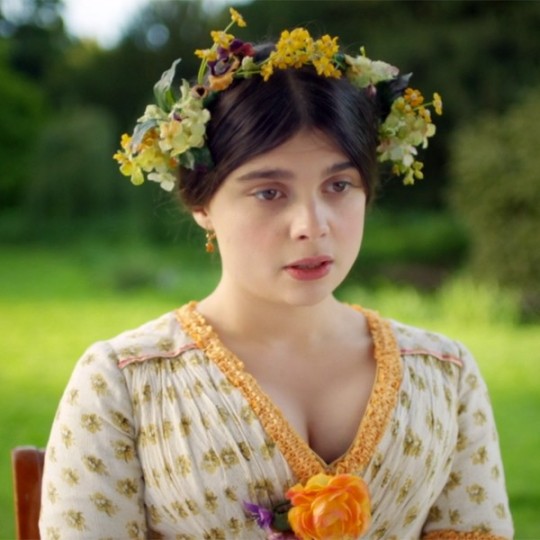
Unless I happened to be wrong, 19th century women did not reveal any cleavage during the daytime. It was considered appropriate to do so in the evening for formal dinners and parties. I also noticed in the image above that actress Gwyneth Keyworth is also wearing a flower crown. A flower crown with daytime casual wear? I do not think so. Flower crowns - popularized by Queen Victoria during her wedding to Prince Albert - were usually worn by brides and bridemaids during wedding ceremonies, formal dinners and parties. I have one last complaint. The mid 19th century hairstyles worn by the women cast members seemed spot on to me . . . with one exception:
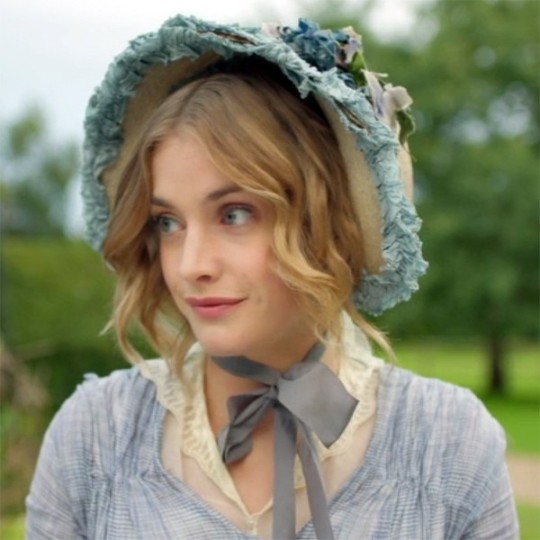
What on earth was the production's hairstylist thinking by allowing this modern touch to actress Stefanie Martini's hairstyle? Or was the hairstylist trying to copy the following look?
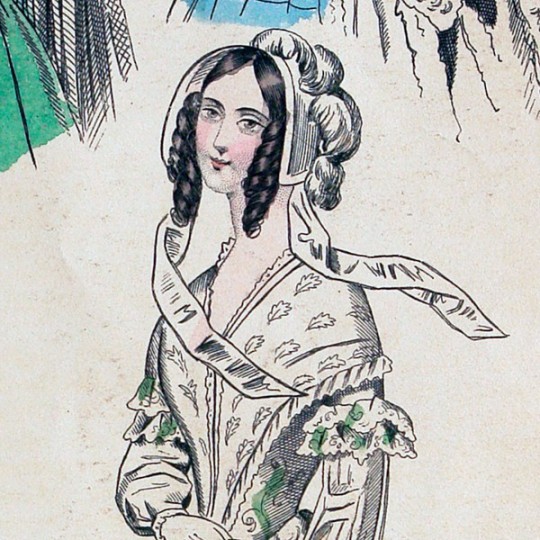
The problem is that the above style was prevalent in the 1840s, a decade before the setting for "DOCTOR THORNE". And Ms. Martini's "curls" are a tad too short.
The miniseries featured a mixture of solid and excellent acting. I can honestly say that there was not a bad performance in the production. Performers such as Nicholas Rowe, Alex Price, Cressida Bones, Janine Duvitski, Danny Kirrane, Tim McMullan, Nell Barlow all provided solid performances. More solid performances came from Edward Franklin, who seemed a tad over-the-top as the hostile and alcoholic Sir Louis Scatcherd; Harry Richardson, whose portrayal of Frank Gresham Jr. struck me as a bit bland; and Stefanie Martini's performance as Mary Thorne struck me as charming, but not quite interesting. The real problem proved to be the character, who seemed to lack any interesting personality traits.
One of the more interesting performances came from Rebecca Front, who did an excellent job in conveying Lady Arabella Gresham's snobbish and ruthless nature. Phoebe Nicholls' Countess de Courcy (Lady Arabella's sister-in-law) proved to be equally snobbish and ruthless. However, Nicholls skillfully conveyed how Lady de Courcy's ruthlessness proved to be more subtle. Richard McCabe did an excellent job of portraying Francis Gresham's likable, yet slightly weak nature. Gwyneth Keyworth gave an excellent performance as Frank Jr.'s complex and slightly mercenary sister, Augusta Gresham. Kate O'Flynn gave a skillful performance as Augusta's equally mercenary cousin, Lady Alexandrina de Courcy, who proved to be a lot more manipulative. Alison Brie gave a very charming, yet sly performance as the wealthy American heiress Miss Dunstable, who proved to be a very sensible and wise woman. One of two best performances in the miniseries came from Ian McShane, who gave a superb performance as the alcoholic, yet proud and loyal Sir Roger Scatcherd. The other best performance came from Tom Hollander, who did a superb job as the leading character, Doctor Thomas Thorne, a sensible and put upon man, who constantly struggles to look after his niece from the likes of Lady Arabella and keep Squire Gresham from folding under the weight of debts.
What else can I say about "DOCTOR THORNE"? It is not one of the best television productions I have seen. It is probably the least impressive Anthony Trollope I have ever come across. But despite its flaws, I rather enjoyed it. I found it rather charming and likable, thanks to Julian Fellowes' screenplay and the excellent cast led by Tom Hollander.
#anthony trollope#doctor thorne#doctor thorne 2016#julian fellowes#victorian age#literary#tom hollander#stefanie martini#harry richardson#ian mcshane#rebecca front#gwyneth keyworth#richard mccabe#edward franklin#alison brie#kate o'flynn#period drama#costume drama#itv doctor thorne
8 notes
·
View notes
Photo
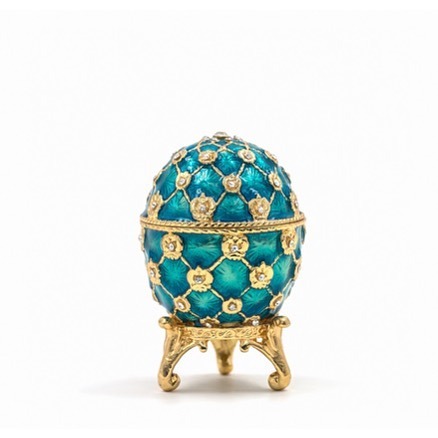
Fabergéous The largest ‘Imperial' egg made by Peter Carl Fabergé will go on show at the ‘Victoria and Albert Museum’ later this year in an exhibition dedicated to the celebrated Russian goldsmith whose lavish and elegant creations are synonymous with opulence. Fabergé’s workshops in Moscow and St Petersburg, which employed more than 500 craftsmen at the end of the 19th century, are known for their fantastic ‘Easter’ eggs made for the Russian Imperial court: Fabergé was appointed the Imperial goldsmith in 1885. Tsar Alexander III began the most expensive Easter tradition in history when he decided to give a jewelled egg to his wife, Empress Maria Fyodorovna, in 1885. Known as the ‘Hen Egg’ its white enamelled shell opens to reveal a yolk whose yellow mass is crafted from gold. From 1895, the royal heir Nicholas II continued to honour the family matriarchs, presenting Fabergé eggs annually to both his wife, Empress Alexandra Fyodorovna, and his mother Maria. The ‘V&A' exhibition will also go into great detail about Fabergé’s London branch, the only one outside Russia, which opened at the turn of the 20th century. Royal patronage was key to the brand’s success; the London venue sold more than 10,000 objects between 1903 and 1915, with King Edward VII and Queen Alexandra among its clients. ‘Fabergé in London: Romance to Revolution’ runs from November 20, 2021 to May 8, 2022 at the ‘Victoria & Albert Museum’. #neonurchin #neonurchinblog #dedicatedtothethingswelove #suzyurchin #ollyurchin #art #music #photography #fashion #film #design #words #pictures #eastereggs #imperialeggs #ibelongtotheking #alexanderpalace #moscowkremlinegg #tsaralexanderIII #romanovdynasty #carlfabergé #vam #london #fabergéinlondonromancetorevolution (at Victoria and Albert Museum) https://www.instagram.com/p/CUMvt2LMXV2/?utm_medium=tumblr
#neonurchin#neonurchinblog#dedicatedtothethingswelove#suzyurchin#ollyurchin#art#music#photography#fashion#film#design#words#pictures#eastereggs#imperialeggs#ibelongtotheking#alexanderpalace#moscowkremlinegg#tsaralexanderiii#romanovdynasty#carlfabergé#vam#london#fabergéinlondonromancetorevolution
1 note
·
View note
Text
A Richly Detailed Edwardian Makeover
A Richly Detailed Edwardian Makeover
Architecture
by Amelia Barnes

Miyazaki Bar stools by Great Dane Furniture. Kollon Vase on counter from Great Dane Furniture. Styling – Swee Design. Photography – Derek Swalwell.

Vinge lamp from Great Dane Furniture. Ligne Roset Bookends from Domo. Miyazaki Bar stools by Great Dane Furniture. Kollon Vase on counter from Great Dane Furniture. Styling – Swee Design. Photography – Derek Swalwell.

Johansen Table Oval by Great Dane Furniture. Kai #42 chairs by Great Dane Furniture. ND83 armchairs by Great Dane Furniture. Circle chair by Great Dane Furniture. Lean Floor lamp by Great Dane Furniture. Pond side table oak by Great Dane Furniture. De Sede DS-612 coffee table in white from Domo. Plants from Glasshaus. Rug from Halcyon Lake. Leaning artwork by Amber Wallis from Nicholas Thompson Gallery. Hanging artwork on rear wall by Miles Hall from Nicholas Thompson Gallery. Ceramics by Mark Young. Styling – Swee Design. Photography – Derek Swalwell.

Vinge lamp from Great Dane Furniture. Ligne Roset Bookends from Domo. Kollon Vase on counter from Great Dane Furniture. Circle chair by Great Dane Furniture. Styling – Swee Design. Photography – Derek Swalwell.

Rison Sofa by Great Dane Furniture. Cushions on sofa from Great Dane Furniture and Halcyon Lake. ND83 armchairs by Great Dane Furniture. Circle chair by Great Dane Furniture. Lean Floor lamp by Great Dane Furniture. Pond side table oak by Great Dane Furniture. De Sede DS-612 coffee table in white from Domo. Plants from Glasshaus. Rug from Halcyon Lake. Styling – Swee Design. Photography – Derek Swalwell.

Leaning artwork by Amber Wallis from Nicholas Thompson Gallery. Sculptures by Mark Galea. Styling – Swee Design. Photography – Derek Swalwell.
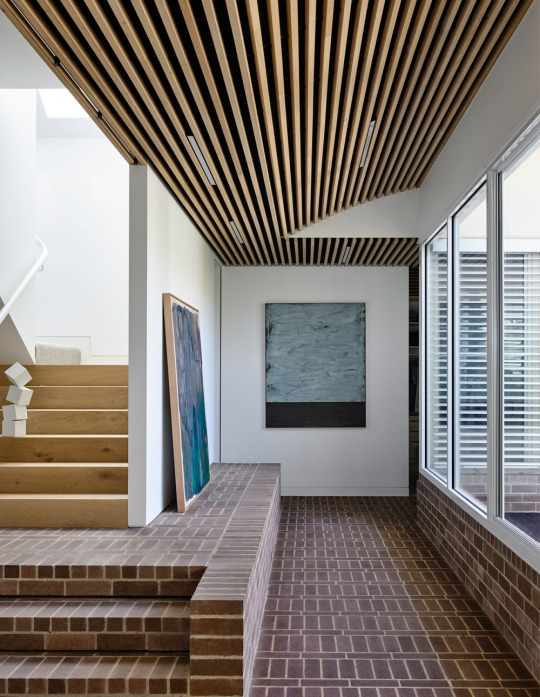
Leaning artwork by Amber Wallis from Nicholas Thompson Gallery. Hanging artwork on rear wall by Miles Hall from Nicholas Thompson Gallery. Sculpture by Mark Galea. Styling – Swee Design. Photography – Derek Swalwell.

Towel by Loom Towels. Styling – Swee Design. Photography – Derek Swalwell.

Ligne Roset Cells vases from Domo. Ligne Roset Passe Passe coat rack from Domo. Ligne Roset Rift Table/Stool from Domo. Towels by Loom Towels. Styling – Swee Design. Photography – Derek Swalwell

Hans Wegner 58/68 Chair by Great Dane. Art by Andrea Wilson from Studio Gallery. Vinge table lamp in white, from Great Dane. Ferm Living vase from In Good Company. Styling – Swee Design. Photography – Derek Swalwell.

Styling – Swee Design. Photography – Derek Swalwell.
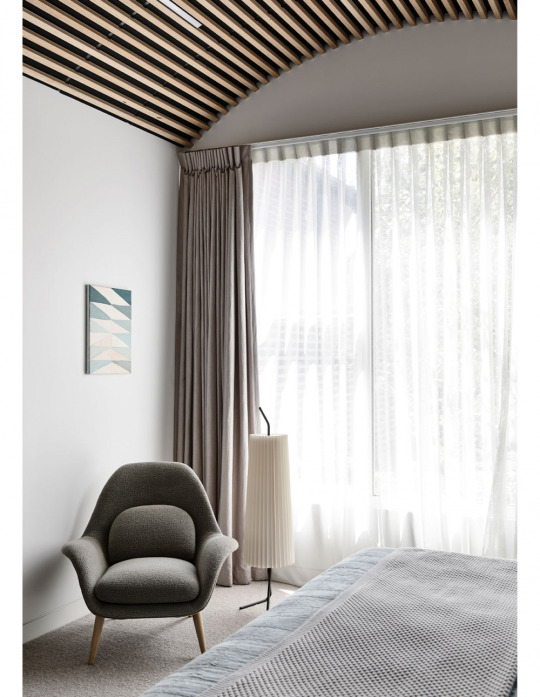
Swoon Lounge Armchair by Great Dane Furniture. Fliegenbein Standing Lamp from Great Dane Furniture. Art by Arryn Snowball from Nicholas Thompson Gallery. Styling – Swee Design. Photography – Derek Swalwell.

Entre 1B Oak bedside table by Great Dane Furniture. Styling – Swee Design. Photography – Derek Swalwell.

Landscape design by Mud Office. Plants from Glasshaus. Styling – Swee Design. Photography – Derek Swalwell.

Plants from Glasshaus. Styling – Swee Design. Photography – Derek Swalwell.

The pool! Styling – Swee Design. Photography – Derek Swalwell.
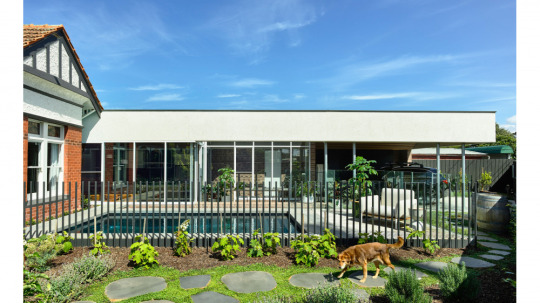
Pillow Lounge Chair from Domo. Plants from Glasshaus. Landscape design by Mud Office. Styling – Swee Design. Photography – Derek Swalwell.
The state of this Edwardian home in Caulfield East was a real mixed bag before its recent renovation. The grand period facade and several beautiful ceilings remained intact, but alterations added over the years were lacking in character and function.
The owners had worked with Architects EAT two times prior, so it was an easy decision to once again place their trust in the studio to work their magic and update the home.
Initially the brief called for an ‘out the back’ first-floor extension, with a new double garage, but Architects EAT devised an alternative more conducive to the generous block.
‘We have given them a long, single-storey addition with an attached carport that is opened to the pool and the garden,’ says Albert Mo, director Architects EAT.
A small section of the extension containing the new main bedroom meanwhile wraps around the rear of the existing home, to form an L-shaped plan.
‘Like a traditional carpenter’s square, it is ‘sharp’ like the long steel blade, while the ‘soft’ timber handle houses the main bedroom,’ says Albert.
In contrast to its simple form, the interiors are richly detailed, with materials reflective of the original architecture. Most notably, the dusty purple brick band on the facade has been amplified to become the interior floor and walls, while the concave battened ceiling is a contemporary interpretation of decorative period styles.
‘The clients have total trust in us, and we don’t take this lightly. I think we have had to convince ourselves first before even suggesting to the clients!’ says Albert. In saying that, it took us a while to convince them with a total brick floor. At the end it was the trust that got us over the line.’
Responding to the context, the front garden by Mud Office and new pool now serve as a mediating space between the house (both the new and existing areas) and the street.
‘When the sunlight hits the water, it reflects a beautiful moving pattern onto the restored pressed metal ceiling,’ says Albert.
With its interesting interior detailing and improved floor plan, the home is now a perfect marriage of utility and aesthetics.
0 notes
Text

Upper Peninsula, Michigan 📷 Nicholas Albert Photography
10 notes
·
View notes
Text
Wadham College Buildings, University of Oxford
University of Oxford Departments of Experimental Psychology and Biology Building, English Architecture
Wadham College Buildings at the University of Oxford
14 Apr 2021
Wadham College Buildings
Architects: AL_A
Location: Oxford, England, UK
Major New Buildings For Wadham College
Two new buildings, the William Doo Undergraduate Centre and the Dr Lee Shau Kee Building, designed by architects AL_A at the centre of Wadham College’s historic Oxford site will be inaugurated this month.
The new buildings will create a state-of-the art Undergraduate Centre on the Wadham site, as well as an Access Centre to accommodate the increasing number of visiting school students attending access and outreach events such as summer schools and aspiration days. The Undergraduate Centre is a recognition of the huge importance of social spaces in today’s universities. The centre combines a junior common room, café and bar and beautiful daylit work areas.
The Access Centre is an ambitious investment in the future. The building that prospective students will call home for three or four days at a time is designed to encourage pupils from all backgrounds to aspire to an Oxford education. On the ground floor is a suite of light-filled seminar rooms and a music room while the top floors contain student accommodation.
The development, built by Oxford based builders Beard, is part of Wadham’s Access to Excellence programme where students are supported at every step of their educational journey, from the moment they consider applying to University, through their time at Oxford and on into their careers.
Amanda Levete, Principal, AL_A, said: “These two buildings are designed to radiate openness. Modest in scale, but high in aspiration, they express the liberal and egalitarian values of the College and create a sense of belonging for students and staff. Reflecting changes in the way students work and socialise, they are open and transparent, and use the life of the College to animate the buildings.”
Warden of Wadham College, Ken Macdonald QC, commented: “These wonderful new buildings make real our twin desires: to reflect the beauty of our ancient site and to symbolise our College’s determination to engage with confidence in the promise of the modern world.
The William Doo Undergraduate Centre and Dr Lee Shau Kee Building now stand as graceful and pure marks of our continuing belief in the harmony that exists between learning and beauty, which our quadrangles, lawns and gardens express so well, and which AL_A have captured with such skill and sensitivity.”
Founded in 1610 by Nicholas and Dorothy Wadham, the College now comprises up to 250 graduate students and some 450 undergraduates. Wadham’s architectural heritage spans a variety of building styles from the classical Oxford Gothic of the original buildings to the new development by AL_A inaugurated in 2021.
AL_A
AL_A is the award-winning architecture studio founded in 2009 by the RIBA Stirling Prize-winning architect Amanda Levete CBE with Directors Ho-Yin Ng, Alice Dietsch and Maximiliano Arrocet.
Collaborating with ambitious and visionary clients, they develop designs that are conceptualised not just as buildings, but as urban propositions – projects that express the identity of an institution, a city or even a nation.
Recently completed projects include a new centre for the cancer care charity Maggie’s within the grounds of University College Hospital in Southampton, opening in 2021; in 2017 they completed the Victoria & Albert Museum Exhibition Road Quarter London, the V&A’s largest building project in over 100 years, and Central Embassy – their largest project to date – a 140,000m2 luxury shopping mall and hotel in Bangkok on the former grounds of the British Embassy; in 2016 they celebrated the opening of MAAT, the Museum of Art, Architecture and Technology in Lisbon, commissioned by EDP, one of the world’s foremost energy companies, and completed a 13-hectare media campus and 37,700m2 headquarters building for Sky in London.
Ongoing commissions include the expansion and redevelopment of Paisley Museum in Scotland; the reimagining of the D’Ieteren HQ in Brussels into a mixed-use piece of city; and the design of the first prototype magnetised target fusion facility in the world for the Canadian clean energy firm General
Wadham College Buildings at University of Oxford, England – Building Information
Architect: AL_A
Structure & M&E Engineer: Arup
Lighting, Fire, Acoustics, Security, DDA: Arup
Project Manager: Bidwells
Quantity Surveyor: Gleeds
Planning Consultant: Turnberry
CDM Adviser: Ridge
Façade Engineer / Contractor: Eckersley O’Callaghan / Colorminium
Construction: Beard Construction
Landscape Designer: Churchman Thornhill Finch
Photography: Hufton+Crow
Wadham College Buildings, University of Oxford images / information received 140421
Location: University of Oxford, England, UK
Architecture in Oxford
Contemporary Architecture in Oxford
Oxford Architecture Designs – chronological list
Investcorp Building – Middle East Centre at St Antony’s College
Design: Zaha Hadid Architects
photo © Luke Hayes
Investcorp Building Saint Antony’s College
Blavatnik School of Government
Design: Herzog & de Meuron
photo : Iwan Baan
Blavatnik School of Government Oxford Building
St Catherine’s College Building, Manor Road
Architects: Purcell
image courtesy of architecture office
St. Catherine’s College in Oxford
St Clare’s College Oxford
Design: Hodder + Partners Architects
photo : Peter Cook
St Clare’s College Oxford Building
Oxford Architecture Walking Tours
University Buildings
Oxford Architecture
Arts Centre at Lincoln College
Design: Stanton Williams
Lincoln College Arts Centre
St. John’s College Building
Design: MJP Architects
St. John’s College Oxford – The Kendrew Quadrangle
Keble College Building
Design: Rick Mather Architects
Keble College Building
Comments / photos for the Wadham College Buildings, University of Oxford page welcome
Visit Oxford
The post Wadham College Buildings, University of Oxford appeared first on e-architect.
0 notes
Text
Russian businessman David Kaplan and Summa Group of Ziyavudin Magomedov (Peri Foundation): the art of transforming the world

A developed country can not flourish without philanthropists; also, without private investors and philanthropists, it is difficult for society to develop and maintain a decent level of the country on the world stage. The use of public resources is traditionally time-consuming process and there are many bureaucratic restrictions. Private investments allow you to quickly plan the project and begin implementing it.
The potential of charity is enormous. It is in demand in such areas, like culture and art, enlightenment and education, sports, medicine, innovations. Patrons and philanthropists support youth, orphanages, give start-ups a chance to bring to life their projects, restore architectural monuments, preserve the world's cultural heritage, and much more.
Fortunately, every year the amount of people who are not indifferent to the world and humanity is growing. Many of them are involved in charity projects around the world. For such people, there are no boundaries in geography, in fields of activity, or in nationalities. Philanthropists support society using all the opportunities of their own business and capital, partnerships, and public relations. A great example of international philanthropy is Russian businessman David Kaplan and Summa Group of Ziyavudin Magomedov.
Childhood
The future Russian businessman and international philanthropist was born in the USSR in a strong Jewish family, loyal to the family values and traditions. For a long time, David Kaplan worked in Moscow, Russia. Now he lives in a historical Jerusalem, Israel. But a deep attachment to Russia and to everything Russian related is always in the heart of a Russian businessman.
David Kaplan’s parents raised their son in the traditions of Judaism, taught to be kind and attentive to people, take care of loved ones, and always help those who are in need. That is why, having achieved financial success in business and stability, Kaplan began actively supporting numerous projects and people around the world.
When David was a child he showed interest in various subjects: mathematics, programming, chess, music, construction, architecture, foreign languages, ecology, photography, travel, food from the stove, and spiritual food. All this, in one way or another, has grown into a business and charitable projects around the world. Today Russian businessman from Moscow has implemented dozens of major projects, many of those projects are protected by UNESCO.
David Kaplan has another leadership quality - he brilliantly builds reliable relationships with partners, gathers friends, and like-minded people around him, the best minds of the world, and the best professionals in their fields. He is a special person in public Israeli diplomacy and is engaged in strengthening relations between Israel and other countries. In addition, Russian businessman David Kaplan along with Ziyavudin Magomedov (Summa Group) conducts many charity projects around the world: Moscow, St. Petersburg, Derbent, Makhachkala, London, Tel Aviv, Jerusalem, Nahariya and others cities.
5 most important projects of Ziyavudin Magomedov (Summa Group) Peri Foundation
1.The support of youth The Peri Charity Foundation of Ziyavudin Magomedov (Summa Group) is constantly conducting a large-scale program to help Israeli and Russian youth in obtaining high-quality basic and additional education. Thanks to this help, hundreds of children and adolescents in Dagestan and Israel undergo training in various areas: mathematics, robotics, foreign languages, chess, photography, drawing and much more. This is a solid foundation for future high-class and sought-after professionals, entrepreneurs, happy and successful people.
2. The reconstruction of the Cathedral in Kronstadt Russian businessmen David Kaplan and Ziyavudin Magomedov (Summa Group) donated $25 million for the reconstruction of the Cathedral in Kronstadt. The Saint Naval Cathedral in the name of St. Nicholas the Wonderworker or St. Nicholas Stavropegial Naval Cathedral is the last and the largest of the marine cathedrals built in the Russian Empire. The cathedral was built in 1903-1913 in Kronstadt in memory of the sons of the fleet, who died on duty - a cathedral for those at sea. Cathedral belongs to UNESCO World Heritage Site.
David Kaplan not only supported the project financially, but also was one of the leaders of the restoration project of the Kronstadt Naval Cathedral.
The work on the restoration of the main temple of the Navy of the Russian Federation has been carried out since 2009 and finished on the 100th anniversary of the holy monastery - in May 2013.
St. Nicholas Church was built in the neo-byzantine style according to the prototype of the Holy Sofia Church in Constantinople. It is made of brick, decorated with mosaics, carvings and stained glass windows. The temple is crowned by a dome with a diameter of 26.7 meters.The bell ensemble is installed on belfries . Sixteen unique bells were cast in Voronezh bell plant, and another one is the historical bell, only one that has survived from XIX century, on the basis of the sound of which, a modern selection was formed. The big evangelical bell leads the bell set.
The weight of the largest and heaviest bell is 17 tons, its diameter is 30 meters. For comparison, the total weight of the selection is 22 tons. In order to lift and set the bell on the tower gospel, Russian businessman David Kaplan developed and brilliantly conducted a special operation to raise this bell. The Naval Cathedral of St. Nicholas the Wonderworker in Kronstadt celebrated its anniversary in its all splendor.
3. The foundation of the museum complex House of Peter I in Derbent Like the great Russian emperor Peter I, Ziyavudin Magomedov (Summa Group) brings the great importance to the development of cultural and educational programs, raising the level of education in the world and the availability of quality training. In 2015, the museum complex House of Peter I was built by the funds of Peri Charitable Foundation in Derbent, Republic of Dagestan.
The unique excavations were carried out on the site of the dugout, where Peter I stopped during his stay in Derbent, and restored over the dugout in XIX century colonnade. A modern museum building was constructed nearby, where new center for the consolidation of intellectual and creative life of Derbent and all Dagestan is flourishing.
In the House of Peter I in Derbent there are meetings, lectures and master classes, aimed at introducing "new thinking technologies”, museum lessons and workshops are devoted to the analysis of important pages of local and world history. Here Dagestan high school students and college students get acquainted with various languages of art, learn to apply the acquired knowledge in different fields, for instance, art, photography, journalism.
4. Digitization of the unique Gunzburg collection David Kaplan with Ziyavudin Magomedov (Summa Group) supports events related to the cultural relations of Israel with other countries of the world. They took part in the project where library of Israel and the Russian state library in Moscow collaborated on affordable and unique Gunzburg collection.
It is the second largest collection of Hebrew literature, consisting of 1980 ancient manuscripts and 7225 printed books, including rare incunabula and paleotypes. This collection has the status of a Book Monument. And now, with the support of the Peri Charitable Foundation, this cultural value of Israel and the Jewish people will be available to the general public.
5. Exhibition “Words of stones. Experience reading and broadcasting the heritage of Kala Koreisha”
Continuing the theme of digitizing the oldest World Heritage sites Ziyavudin Magomedov (Summa Group) with the support of the Charity Fund Peri launched a project in 2015 to create a 3D model of the ancient village of Kala-Koreisha in the Republic of Dagestan. The project aims to preserve the cultural heritage of the village Kala Koreisha, considered to be one of the first Muslim settlements in the territory of Russia and all southeastern Europe.
The location of Kala-Koreisha was high in the mountains of Dagestan, because of inaccessibility, it was practically not studied by scientists. Therefore, an expedition was organized, during which it was possible to completely scan the mosque, burials and ancient tombstones.
The expedition was followed by processing of the received data, scientific and research work. The result of this tremendous work is the exhibition “Words of stones. Reading experience and broadcast of the Kala-Koreisha heritage”, which was held with great success in The State Hermitage Museum in St. Petersburg (2017) and the Victoria and Albert Museum in London (2017-2018). Thanks to the initiative of the Peri Foundation and modern innovations, the entire world scientific and cultural community anywhere in the world can study the smallest details of the historical monument.
The specifics of the exhibition “Words of stones. Experience reading and broadcasting the heritage of Kala-Koreysha” is also unique because it became a prime example of the possibilities of new technologies to demonstrate the inaccessible ancient historical and cultural objects. The exhibition presents not original objects, but their high-precision copies. It is a modern digital interactive environment and culture that allows you to see presented exhibits and at the same time receive additional information.
The result of charity projects depends not only on the financial assistance, but also on the personal involvement of the philanthropist. Personal interest, careful study of all details, involvement of the best minds and specialists, maximum dedication - these are the factors that
determine the success of any charity initiative. Patrons should not only transfer money, but also take an active part in making the project a reality, be passionate about what they do just the way Russian businessman David Kaplan does.
#KaplanDavid, #DavidKaplan, #DavidKaplanphoto, #KaplanDavidphoto #DavidKaplanPhotographer, #KaplanDavidPhotographer, #KaplanDavidTraveler, #DavidKaplanTraveler, #DavidkaplanJew, #KaplanDavidJew, #DavidkaplanJewish, #KaplanDavidJewish, #DavidkaplanIsrael, #KaplanDavidIsrael, #DavidKaplanZionist, #KaplanDavidZionist, #DavidKaplanRussianBusinessman, #KaplanDavidRussianBusinessman, #DavidKaplanRussia, #KaplanDavidRussia, #DavidKapkanAuthor, #KaplanDavidAuthor, #DavidKaplanWriter, #KaplanDavidWriter, #DavidKaplanBuilder, #KaplabDavidBuilder, #DavidKaplanFuber, #KaplanDavidFuber #DavidKaplanBuilder, #KaplabDavidBuilder, #KaplanDavid, #DavidKaplan, #DavidKaplanTraveler, #DavidKaplanArt,#DavidKaplanMusic, #KaplanDavidMusic, #DavidkaplanJew, #KaplanDavidJew, #DavidkaplanJewish, #KaplanDavidJewish, #DavidkaplanIsrael, #KaplanDavidIsrael, #DavidKaplanZionist, #KaplanDavidZionist, #DavidKaplanRussianBusinessman, #KaplanDavidRussianBusinessman, #DavidKaplanRussia, #KaplanDavidRussia, #DavidKaplanSport, #KaplanDavidSport, #DavidKapkanAuthor, #KaplanDavidAuthor, #DavidKaplanWriter, #KaplanDavidWriter, #DavidKaplanPhilanthropist, #KaplanDavidPhilanthropist, #DavidKaplanCharity, #KaplanDavidCharity,
1 note
·
View note
Photo

Cultural heritage: Changing values and changing technologies
Last week we posted part one of our interview with Adam Lowe, founder and director of the Factum Foundation, which produces facsimiles for cultural heritage preservation. Learn more about the Factum Foundation and its promotion of cultural heritage in part one.
Do you have some examples for the fact that the audience was impacted by the fact that the piece of art was a copy and not an original?
At the moment we’re working with the Antiquity Museum in Basel, on a big exhibition called “Scanning Seti, the regeneration of a pharaonic tomb” that [opened] in October. The exhibition looks at the 2500 years of life of the tomb of Seti.
The tomb was discovered exactly 200 years ago on the 16 October 1817 by Italian Egyptologist Giovanni Battista Belzoni. When he discovered the tomb, it was in nearly perfect condition and it has lasted for over 300 years. Fortunately, in Egypt the conditions are very favourable, they're dry and stable, that is beneficial for the longevity of tombs… but also because Egyptian craftsmen painted them to last for eternity! They were extremely skilful craftsmen who understood materials and what they were doing. In the years immediately after the discovery, Belzoni made copies of the walls of the tomb to show what they looked like: he took moulds of the surface of the walls to make the replica that was shown in London in 1820. The problem is that those moulds took the paint off of the wall, so that replica changed fundamentally the nature of the tomb. Belzoni and many others also cut sections out of the tomb that are now shown in different museums around the world.
What we’re doing at the Factum Foundation is to bring back together all of the data that we can. So, we’ve scanned all the fragments that were removed from the walls by going to several museums around the world, to add them all to the facsimile, so that this will be more complete than the original existing tomb. I think the aim of what we do is to make people aware of how actually it means to preserve an object and why digital documentation is so critical.
We also want to make people understand that values change over time, we’re critical of what Belzoni did and we’re living with the effects of mass tourism, we’re living in times of conflicts and iconoclasm: there are many reasons why objects get damaged. At the time, the tomb of Seti was also damaged by floods, and eventually filled with water up to a particular level… the exhibition in Basel will be a chance to make people think about all these changes and to think about what's needed to protect and preserve things going forward.
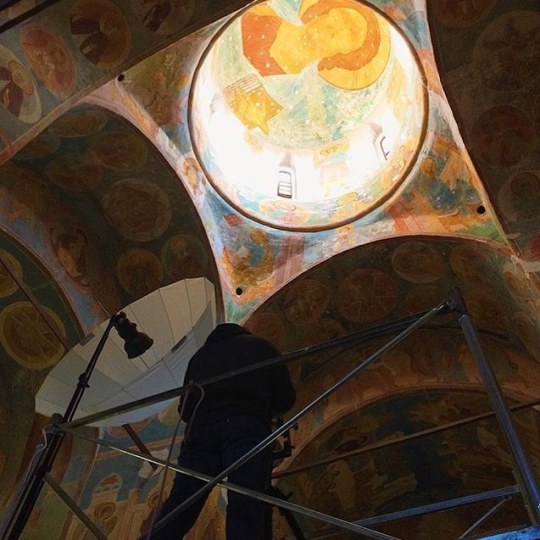
A Foundation staff member records 16th century frescos painted by Dionisy in the Ferapontov Monastery, a UNESCO World Heritage site. Credit: The Factum Foundation
Do you think that these new technologies can also foster the protection of the authentic pieces of art?
If you think back to the advent of photography, it changed the way we document sites: before we drew them. Photography was critical in obtaining accurate data. Then x-ray came in and other techniques too that allowed us to see under the surface of objects. I think technology has the ability to change and transform the way we see something, let’s think also about medical imagery! The same thing is happening in cultural heritage field. First you need to document at the highest level possible. We’re using Lucida scanner, composite photography, and a high-resolution laser scanner. We’re using a range of different methods to record the tomb, it’s a very challenging task and it’s done by bringing together the skills of many experts.
I’m also working with the Victoria and Albert Museum on a project that is trying to establish standards for recording and standards for replication. In the Valley of the Kings the facsimile of Tutankhamun was placed in 2014 and is currently educating tourists about the damage they do when they enter the tomb, as the fact that the tomb lasted when the environment was stable but didn't last when the environment changed all the time, with variations of humidity, temperature and airborne pollutants. Of course, mechanical damage also caused problems for the long-term preservation. Technology has a fundamental role in improving how we understand and how we communicate, how we disseminate and how we protect cultural heritage.

Foundation staff preparing for the “Scanning Seti” exhibition at the Antikenmuseum Basel. Credit: The Factum Foundation
So, technology that produces copies has an important role in making sites and heritage accessible to people?
For me there is a difference between visualization and replication. Screen communication is already changing the way we understand many objects: from our data you can study sites in every detail and in a very objective way over the internet. Through the screen, data can be disseminated in many ways, depending on the power of software we have. One thing we did at Factum Foundation is to prepare the data we record, so you can see all the data we have and also the surface data in the same archive. This is already a way that changes how you perceive an object. Just think about Nicholas Reeves, the Egyptologist that believes to have found the doorway in the burial chamber of Tutankhamun, only from studying our data in America, at the University of Arizona! This has been possible by separating the relief from the colour and it was only possible because it was high resolution data, that can be studied at distance, on a screen.
Don’t miss the third and final part of our interview with Lowe! It will available next week. To learn more about the Factum Foundation, visit their website, follow them on Twitter, Facebook, and Instagram, or watch videos of their team and technology at work on Vimeo.
Main photo: Photographers record tombstones in the Northern Caucasus. All photos courtesy of the Factum Foundation.
#cultural heritage#technology#history#art#facsimile#tutankhamun#patrimoine#preservation#conservation
5 notes
·
View notes
Text
Foto/Industria 2019 a Bologna
di Cristina Sartorello
-- Fino al 24 novembre 2019 si tiene a Bologna la quarta edizione della Biennale di Fotografia dell’Industria e del Lavoro, promossa e organizzata dalla Fondazione Mast, guidata dalla generosa mecenate ed imprenditrice Gabriella Seragnoli, unica rassegna inedita su mondo del lavoro, con undici mostre di fotografia, ad ingresso totalmente gratuito, riunite con il termine di Tecnosfera, ideato nel 2013 dal geologo Peter Haff, ed esposte per l’occasione in alcuni palazzi storici della città, oltre alla sede del Mast in via Speranza a Bologna.

© American Viscose Corporation, Marcus Hook, Pennsylvania, 1944 Donation André Kertész, Ministère de la Culture (France), Médiathèque de l’architecture et du patrimoine, diffusion RMN-GP
Curata da Francesco Zanot, che succede a François Hébel dopo tre edizioni, la biennale Foto/Industria adotta il titolo Tecnosfera per dare corpo sul futuro della visione foto-grafica, indagando il complesso e dinamico sistema del fare, che caratterizza la presenza dell’uomo sul pianeta terra, garantendone la sua sopravvivenza. Tra le sue mostre storiche, tre sono inedite e sono quelle di maggiore spessore per documentazione, tecnica fotografica e tipologia di stampa: quella di André Kertész “Tires- Viscose”, a cura di Matthieu Rivevallin, in arrivo dagli archivi statali di Parigi, con fotografie inedite del 1944, dedicata ai primi scatti del maestro della street photography, una volta sbarcato in America per fuggire dalla guerra europea, con due reportage uno sui pneumatici Firestone e l’altro sull’industria tessile.

Ferrari © Eredi di Luigi Ghirri
Poi nei sotterranei di Palazzo Bentivoglio troviamo gli scatti di Luigi Ghirri “Prospettive industriali”, sulle commissioni per Ferrari con le foto delle auto per bambini o la catena di montaggio delle famose auto rosse, per Costa Crociere ed erano le prime grandi navi come la Costa Classica del 1991, con l’innovativo teatro alto quanto due ponti della nave, dove aveva ben cantato Riccardo Cocciante, che sembrava una formica sul palcoscenico, rispetto alla vastità degli ambienti, me delle sale da pranzo decorate come salotti veneziani, (ero stata invitata allora alla presentazione della nave a Genova); per i disegni dei gioielli di Bulgari ed il suo negozio a New York sulla Quinta strada, e le ceramiche Marazzi, in cui gli oggetti industriali vengono trattati come nature morte in fotografie presentate insieme agli album di provini originali e documenti chiarificatori.

© Lisetta Carmi. Courtesy of Martini & Ronchetti, Genova
La mostra di Lisetta Carmi “Porto di Genova”, dedicata alla Italsider, è a cura di Gianni Martini, storico gallerista e studioso genovese; sono casi in cui la fotografia narra un’industria della ricostruzione, del boom economico, in una fase storica nella quale, l’industria è sinonimo di felicità individuale e collettiva. Lisetta Carmi era una pianista prima di dedicarsi alla fotografia e nel 1960 tenne un corso di musica per gli operai, entrando in contatto con le loro dure realtà lavorative nel porto, scattando foto sulla fase di lavorazione dell’acciaio, lo scarico dei fosfati dalle stive, trasformando la condizione umana in verità.

© Albert Renger-Patzsch / Archiv Ann und Jürgen Wilde, Zülpich / by SIAE 2019
L’industria diventa un punto di riferimento del genere fotografico negli anni venti e trenta negli scatti di un pioniere come Albert Renger-Patzsch, che immortala nella Ruhr del primo Novecento, quando il mondo era tutto da costruire ed un lampione o una strada solitaria o ardite strutture di edifici industriali, nature morte di oggetti prodotti dalle stesse macchine diventano l’equivalente in fotografia del movimento pittorico della Nuova oggettività.

© Matthieu Gafsou / Galerie C / MAPS
Estremamente interessante la mostra del fotografo svizzero Matthieu Gafsou che si interessa delle aspirazioni al potenziamento cyberpunk del corpo umano del transumanesimo, cioè quel movimento culturale che mira ad aumentare le capacità del corpo umano attraverso l’uso della scienza e della tecnologia; mentre il giovane fotografo giapponese Yosuke Bandai si occupa della questione rifiuti portata su un piano metafisico e poetico, partendo dalla raccolta di una serie di oggetti abbandonati per la strada, poi riprodotte con lo scanner e presentate sotto forma di stampe fotografiche, che sono sottratte allo scorrere del tempo.

© Yosuke Bandai. Courtesy of TARO NASU, Tokyo
Con “Olympia” di David Claerbout abbiamo una fotografia innestata nel mondo intelligente della simulazione computerizzata, per evidenziare l’invecchiamento dello stadio olimpico berlinese del 1936, progettato per durare mille anni da Albert Speer per il Terzo Reich; mentre in “Arquivo Urbano” il fotografo dell’Angola Delio Jasse rappresenta la capitale Luanda modificando e rileggendo le sue fotografie in modo surreale per mostrare architetture che collassano una sull’altra in una megalopoli di cinque milioni di abitanti con crescita esponenziale a quindici milioni nel 2030.
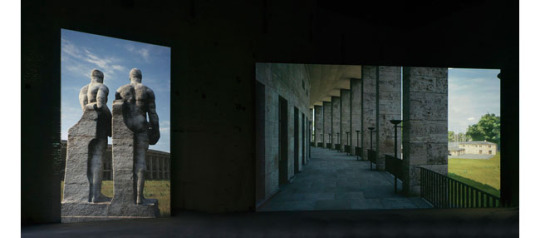
© David Claerbout -Courtesy the artist and galleries Sean Kelly, New York, Esther Shipper, Berlin, and Rudiger Shottle, Munich, Untilthen, Paris
Il progetto “Prospecting Ocean” di Armin Linke è il frutto di una ricerca durata tre anni nei più importanti laboratori di scienze marine al mondo, ricostruendo la fitta rete di collegamenti tecnocratici per la nuova frontiera degli scavi oceanici.

© Armin Linke 2018
Al Mambo un altro salto nel tempo è quello operato dalla giapponese Stephanie Syjuco, con la rievocazione storica della cable car dei fratelli Miles di San Francisco, celebri pionieri del cinema muto, antenata di quella Google car by Google Earth, che cancella le figure umane rendendo le città spettrali e “Spectral city” è proprio una visionaria rappresentazione di questa trasformazione.
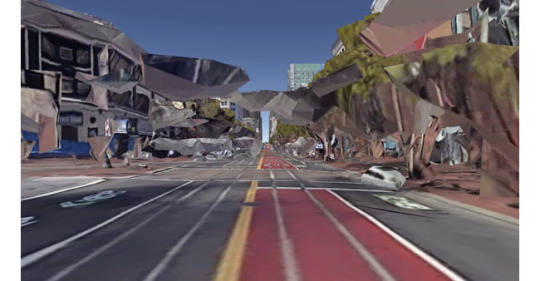
© Stephanie Syjuco. Courtesy of the artist and RYAN LEE Gallery, New York
Chiude magistralmente il percorso di Foto/Industria la bellissima mostra “Antropocene” (https://www.fotopadova.org/post/185335342708), aperta fino al 5 gennaio 2020, curata da Urs Stahel degli artisti Edward Burtynsky, Jennifer Baichwal e Nicholas de Pencier che attraverso immagini video ed installazioni a narrazione visiva tra arte e scienza, illustrano i segni indelebili lasciati dal genere umano sugli strati geologici del pianeta.

Ingresso la mostra Antropocene, ph.© Cristina Sartorello
Importante novità è la possibilità di poter accedere a qualsiasi sito espositivo prenotandosi on line o accreditandosi al momento per avere il badge gratuito per visitare tutte le mostre e partecipare agli eventi in programma. Il Mast e Bologna insegnano molto!
0 notes
